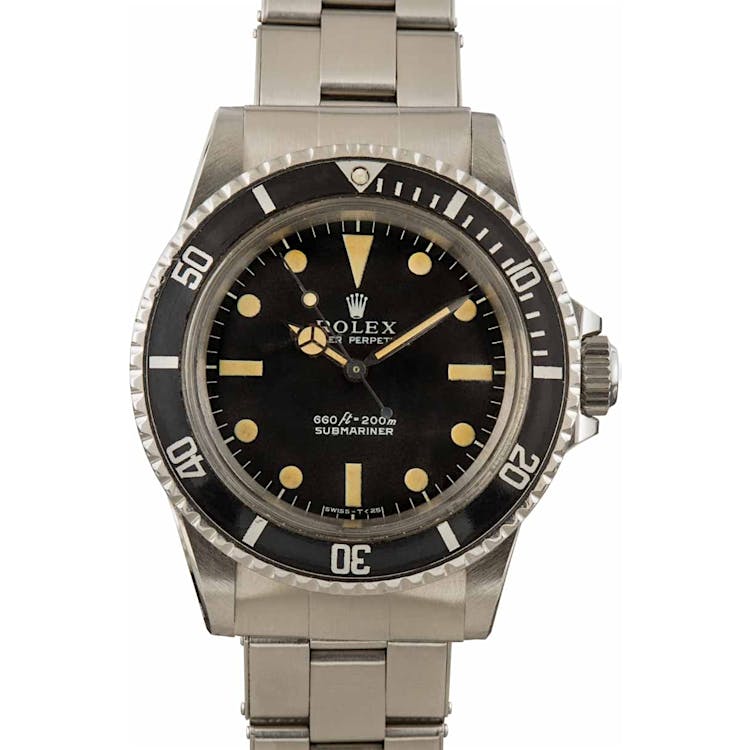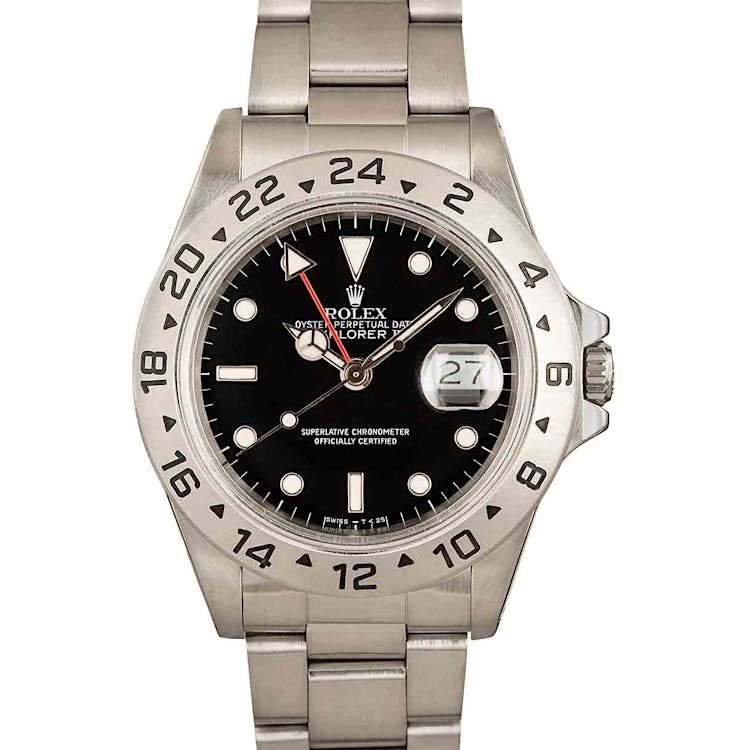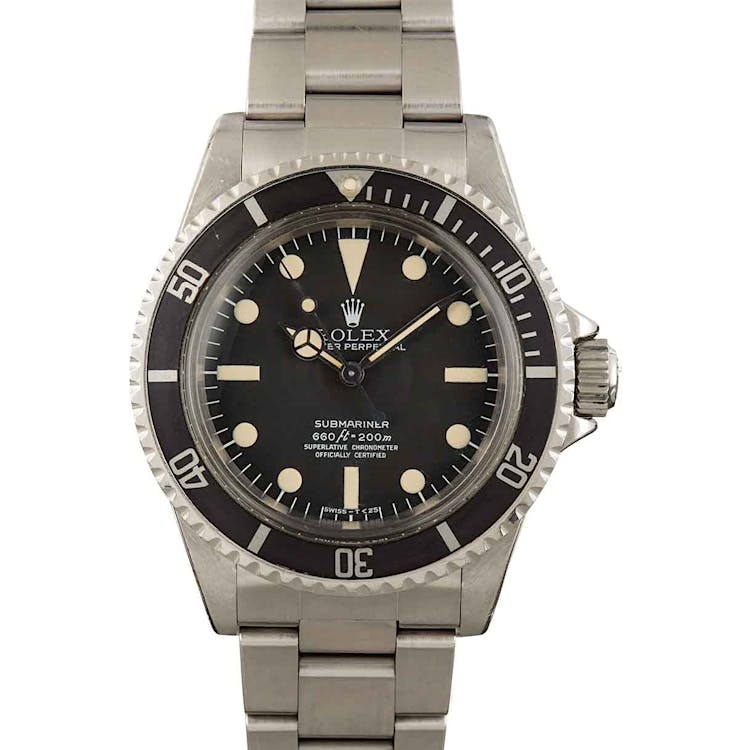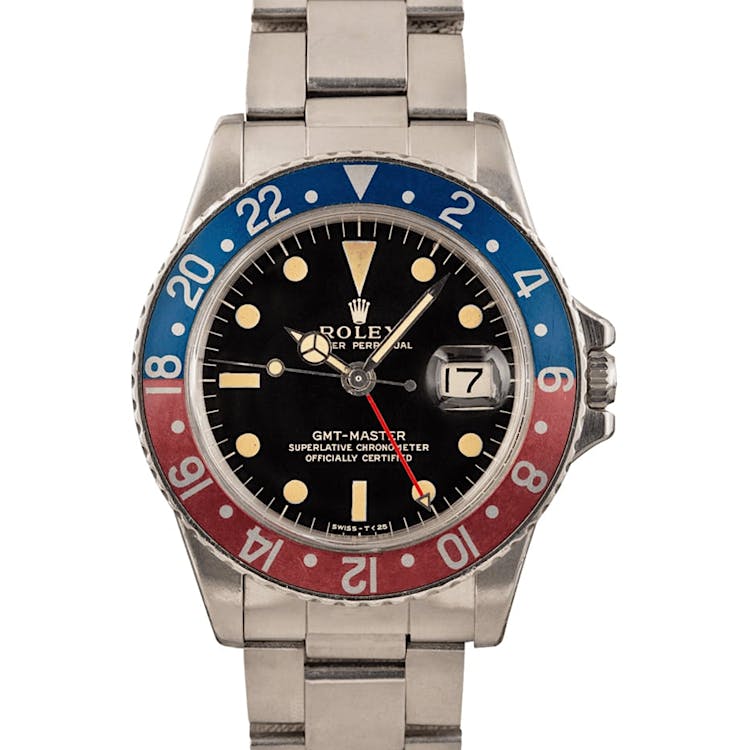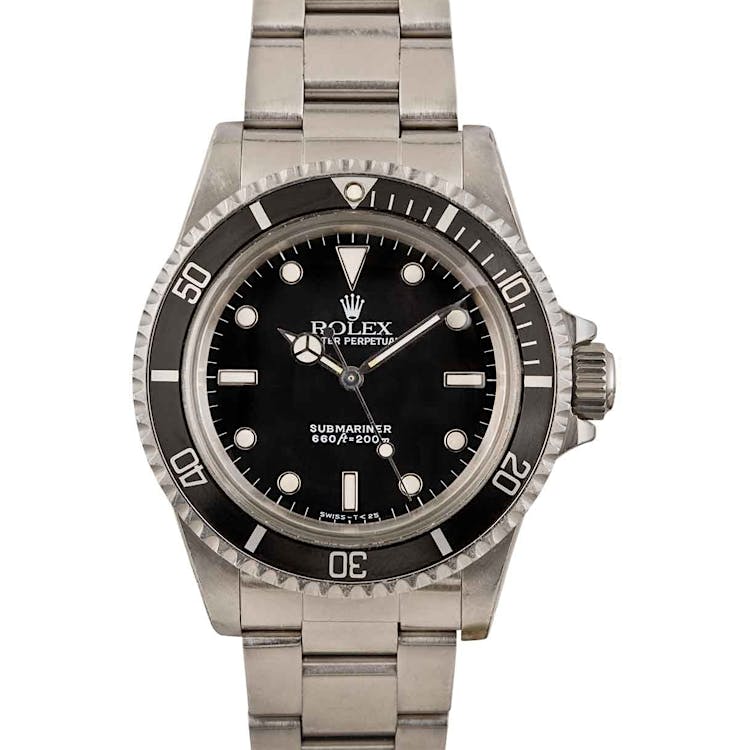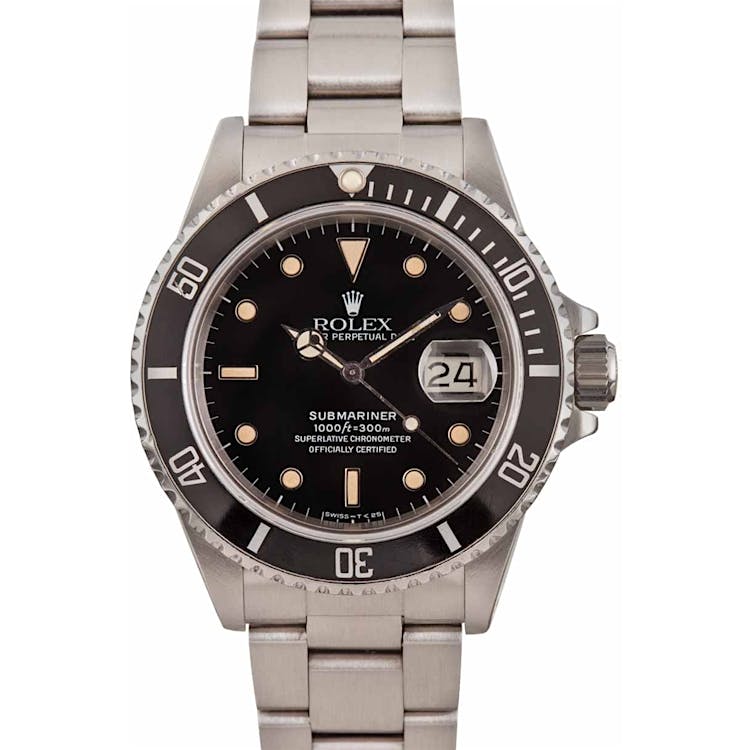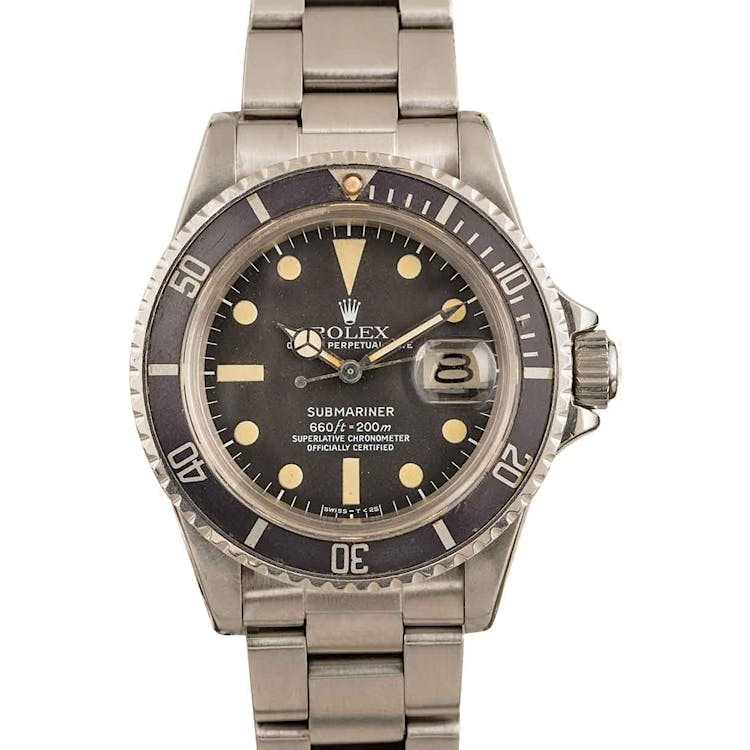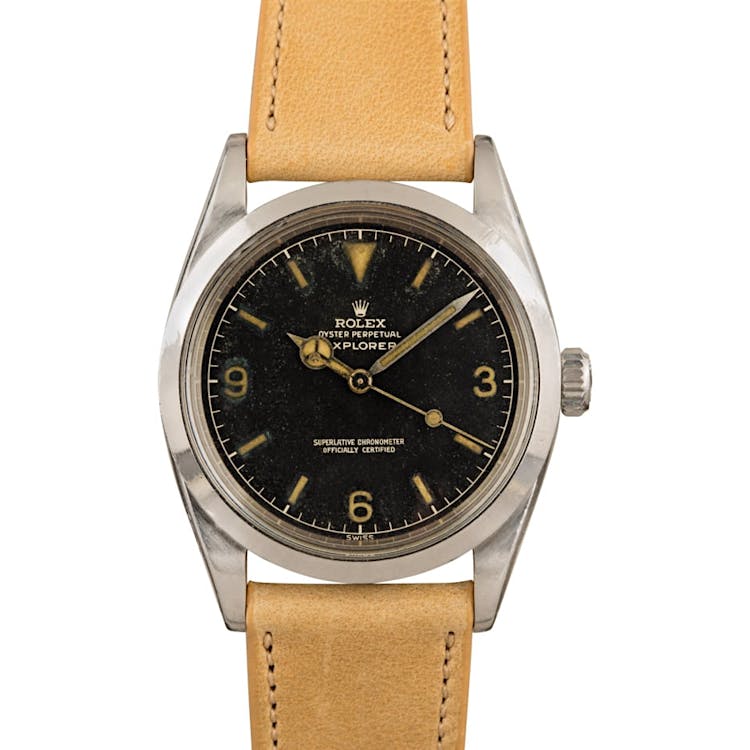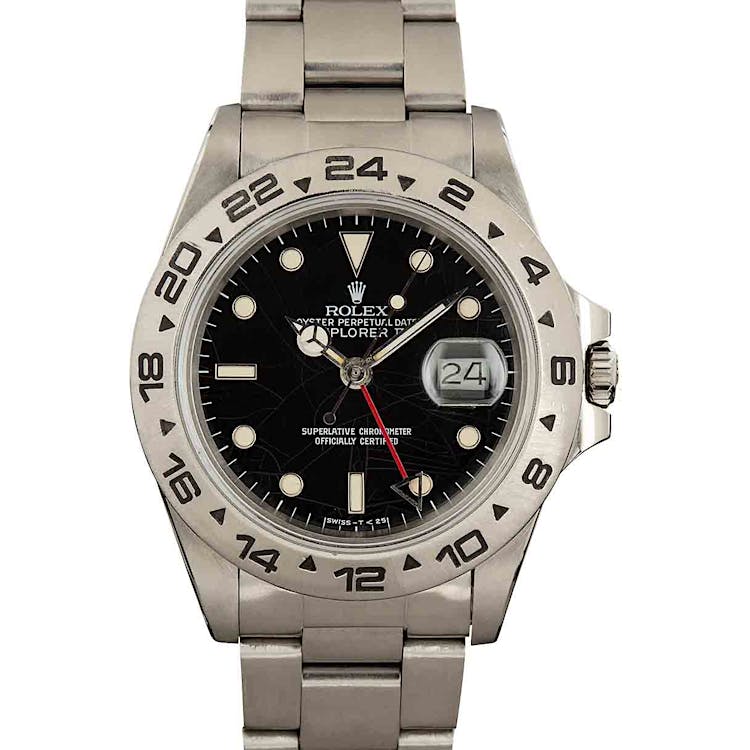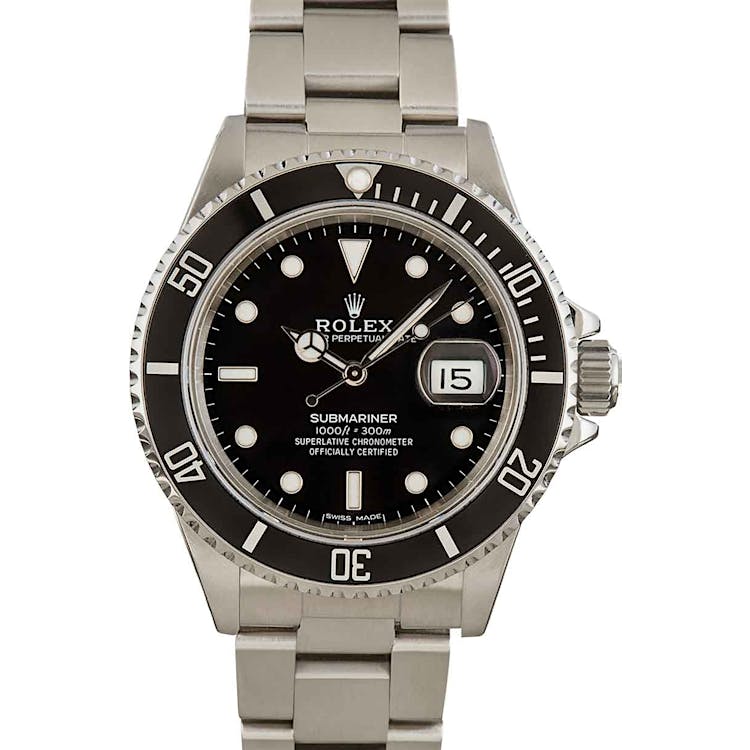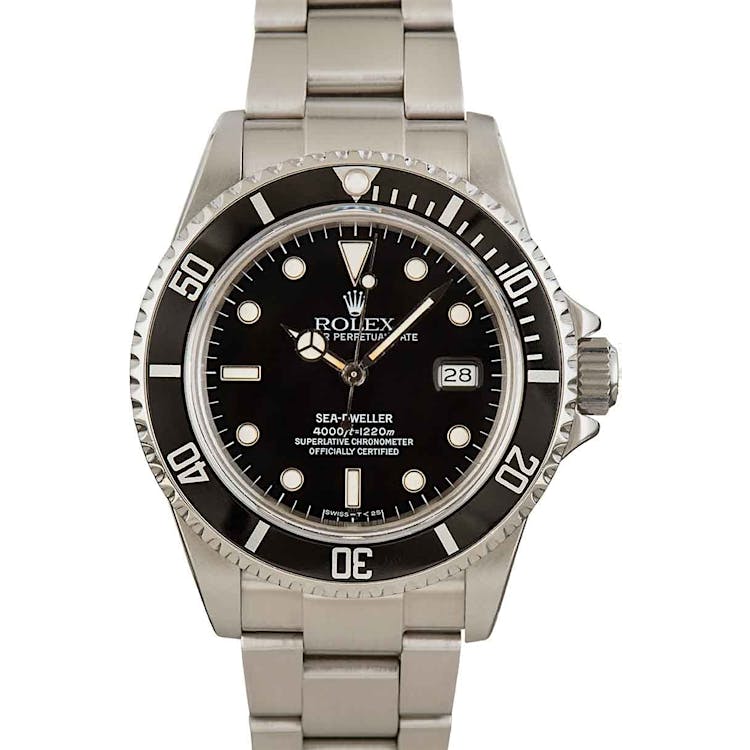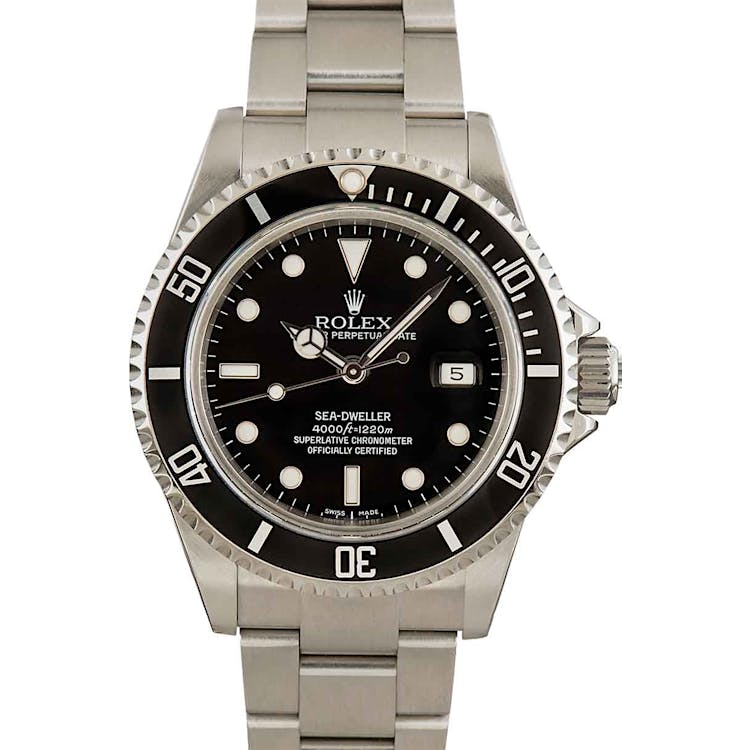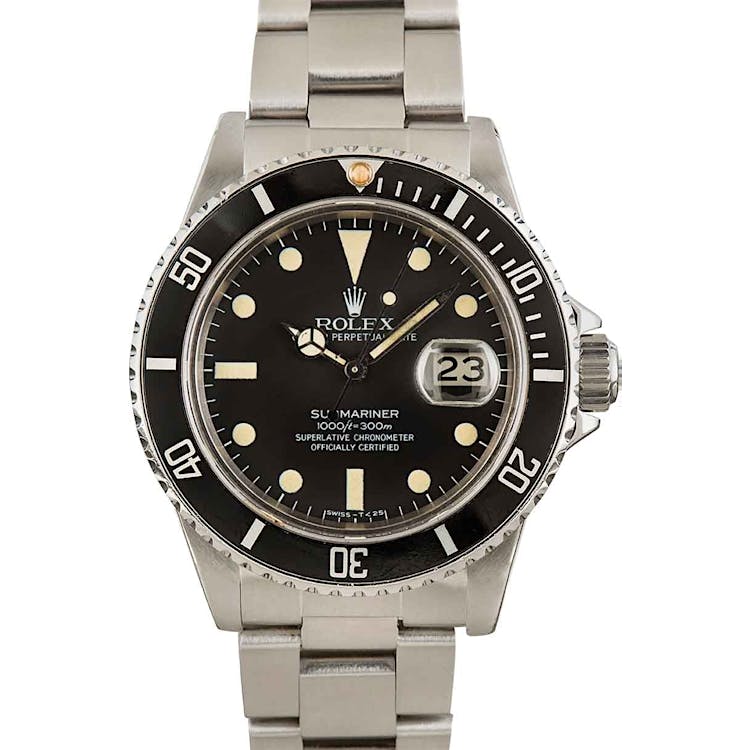Vintage Rolex
- Rolex
- Vintage
Filter By
Cash wire prices shown. Prices may be higher if other payment methods are selected.*
About Vintage Rolex Watches
Within the vintage luxury watch market, Rolex watches reign supreme. Some argue that vintage Patek Philippe watches are at the very top, but the limited availability and often exorbitant price points of most models permit a much smaller group to collect them. Additionally, many vintage Rolex models rival Patek Philippe watches when it comes to both value and desirability, and a remarkably diverse range of variation exists among vintage Rolex models, making them intriguing targets for individuals to pursue and collect.
On the other hand, vintage Rolex watches offer a much larger playing field for watch enthusiasts to enjoy thanks to a wide range of price points and a bevy of different models available. Whether for the novice watch collector with a smaller budget or the seasoned collector with ample cash to spend on timepieces, there are plenty of different vintage Rolex watches to choose from, and all make excellent additions to any collection.
How Much Is A Vintage Rolex Watch?
Due to the immense scope of vintage Rolex watches and all the varying factors that can impact its value, it is just about impossible to pinpoint an accurate price range.
Some models, like vintage Oyster Perpetual, Oysterdate, Oyster Perpetual, and Air-King watches are relatively affordable while select vintage Daytona, GMT-Master, Submariner, and Sea-Dweller watches are some of the most expensive vintage Rolex watches in today’s market. Other vintage Oyster Professional watches such as the Milgauss, Explorer, and Explorer II can also command high prices in the secondary market—particularly if they have special design traits coveted by collectors. Somewhere in the middle of the price range are dress watches like vintage Datejust and Day-Date watches.
To better answer the question as to how much is a vintage Rolex watch, we've highlighted the starting prices of some popular vintage references in the below table.
| Rolex Watch | Model | Second-Hand Price | Materials |
|---|---|---|---|
| Daytona | Ref. 6239, 6241, 6262, 6264, 6265, 6263 | from $50,000 | Stainless Steel or Yellow Gold |
| Daytona "Paul Newman" | Ref. 6239, 6241, 6262, 6264, 6265, 6263 | from $200,000 | Stainless Steel or Yellow Gold |
| GMT-Master | Ref. 6542 | from $180,000 | Stainless Steel or Yellow Gold |
| GMT-Master | Ref. 1675 | from $15,000 | Stainless Steel or Yellow Gold |
| Submariner | Ref. 6538 | from $150,000 | Stainless Steel |
| Submariner | Ref. 5512 | from $15,000 | Stainless Steel |
| Submariner Date | Ref. 1680 | from $9,950 | Stainless Steel or Yellow Gold |
| Sea-Dweller | Ref. 1665 | from $20,000 | Stainless Steel |
| Explorer | Ref. 1016 | from $12,995 | Stainless Steel |
| Explorer II | Ref. 1655 | from $17,950 | Stainless Steel |
| Milgauss | Ref. 1019 | from $24,950 | Stainless Steel |
| Day-Date President | Ref. 1803 | from $9,495 | 18k Gold (Yellow, White, Pink) |
| Datejust | Ref. 1601 | from $3,195 | Stainless Steel, Gold, or Two-Tone |
| Air-King | Ref. 5500 | from $2,795 | Stainless Steel, Gold, or Two-Tone |
| Oyster Perpetual Date | Ref. 1500 | from $2,795 | Stainless Steel, Gold, or Two-Tone |
| Oysterdate | Ref. 6694 | from $2,795 | Stainless Steel |
What Details Influence Vintage Rolex Prices?
Many factors can influence the price of vintage Rolex watches. It’s not uncommon to see different examples of the exact same Rolex reference selling for vastly different prices on the open market. One of the most important guidelines to consider when collecting vintage watches is that authenticity and condition are crucial, and can have a significant impact on resale value.
Authenticity is always paramount, and a Rolex watch as close as possible to its original condition (with original dial, hands, crystal, bracelet, unpolished case, etc.) will command much higher prices than one with aftermarket or later-era replacement components.
- Authenticity
- Condition
- Original Parts
- Provenance
- General Rarity
- Unusual Features
- Current Demand
Collectible Vintage Rolex Watches
Vintage timepieces have risen in popularity and demand over the last 5--10 years with some models selling for more than a million dollars at auction houses. For example, some Paul Newman Rolex Daytona models, such as the 6239, 6240, 6263 and 6265, are now valued at over $150,000.The November 10th, 2013 Christies auction in Geneva, the Rolex Daytona "Lesson One" 50 exceptional examples of the world's most celebrated chronograph wristwatch auction, realized over $12,000,000 for 50 watches or on average of $250,000 per watch. The most expensive Rolex watch ever sold at auction was Paul Newman's own Daytona Paul Newman, purchased for $17.8 million in 2017.
With a watchmaker as prolific as Rolex, it can be hard to determine which vintage Rolex watch models are collectible. Below is a quick overview of some of the most sought-after or covetable vintage Rolex watches in the market.
Vintage Oyster Perpetual Bubble Backs
In 1931, Rolex introduced the Perpetual movement, which included a winding rotor so that the movement would self-wind. Rolex's first self-winding calibers would lay the groundwork for almost-all future Rolex watches-a company now famous for its collection of durable, serviceable, and high-quality automatic movements.
Early automatic Rolex watches included protruding casebacks to accommodate the addition of the winding rotor. This distinct case shape has led the watches' collective nickname, the Rolex Bubble Back-also known as the Rolex Ovettone (Italian for "little egg"). The Rolex Bubble Back models were the first to combine the waterproof Rolex Oyster cases with the automatic Rolex Perpetual movements, therefore birthing the now famed Rolex Oyster Perpetual concept.
Sizes of vintage Rolex Oyster Perpetual Bubble Backs are small by today’s standards, 32mm to 34mm depending on the reference. Over the decades the Bubble Back was made in a variety of styles and metals including steel, gold, and two-tone steel. The 1980s were the heyday for vintage Oyster Perpetual Bubble Back collecting as they became sought-after in the Japanese market. Today, Rolex Oyster Perpetual Bubble Back models can start in the low thousands price range-which is an unbelievable deal considering the significance of this model on not only Rolex's history but also on watchmaking's history at large.
Vintage Datejust
In 1945, Rolex launched the Datejust watch to celebrate the company's 40th anniversary. The Datejust naturally included the company’s signature Oyster case and Perpetual movement, but it also offered a few novel details.
First, there was the date window on the dial after which the model is named. In fact, the Rolex Datejust was the first automatic chronometer-rated wristwatch to display the date via a window. Another novelty of the Datejust was its bracelet, aptly named the Jubilee bracelet due to the commemorations. Featuring a five-link configuration, the Jubilee is now one of Rolex’s most famous bracelet designs. The now-ubiquitous Cyclops date magnification lens joined the Datejust in the mid-1950s and subsequently rolled out to other Rolex models with date windows.
Originally, the date feature on the Datejust was not quickset, which means that to change the number in the window, the timekeeping hands have to be continuously advanced past midnight. However, in 1977, Rolex introduced Caliber 3035 and along with it, brought about the quickset date feature to the Datejust so that the date could be set independently from the time.
The Datejust has grown to become Rolex's flagship watch, not only available in an assortment of metals but also with a variety of bracelet styles, bezel finishes, and dial colors. Given the large variety, prices for vintage Datejust watches vary wildly. However, a good place to start is with either the non-quickset Datejust 16xx references from the 1960s and 1970s or the quick-set Datejust 16xxx from the 1970s and 1980s. Prices for vintage Datejust models start around the low thousands and can quickly go up from there.
Vintage Rolex Triple Calendar Moonphase
In the 1940s and 1950s, Rolex made a handful of complicated models that have since become exceedingly coveted in the vintage market. Two examples are the Rolex Triple Calendar Moonphase references 8171 and 6062 with day window, a month window, a date indicator around the dial periphery, and a moon phase display. Produced from approximately between 1949 and 1952 both models were made available in steel, rose gold, and yellow gold. The main difference between 8171 and 6062 is that 8171 has a 38mm non-Oyster case while 6062 has a 36mm Oyster case. The Rolex 8171 is often referred to as the "Padellone" (Italian for "big frying pan" due to its large-for-the era size.
Given their age, rarity, and complexity, the Rolex Triple Calendar Moonphase models are expensive vintage watches, often selling for hundreds of thousands of dollars and sometimes into the millions.
Vintage Rolex Triple Calendar Chronographs
Some of the most complicated watches ever made by Rolex are its Triple Calendar Chronographs, which includes five references produced from the late 1940s until the early 1960s. Commonly referred to as the Dato-Compax or the "Jean-Claude Killy" (nicknamed after the champion alpine skier who was rumored to wear one), the Triple Calendar Chronograph references include ref. 4768, 4767, 5036, 6036, and 6236. The Dato Compax ref. 4768 was the only non-Oyster cased reference with a snap-on caseback and the remaining references all featured water-resistant Oyster cases with screw-down casebacks.
Combing calendar indications and a chronograph complication, the Rolex Killy watch dials include a date indicator border, a day window, a month window, and three subdials. What's more, the Dato-Compax models were antimagnetic watches, complete with "Antimagnetique" text on the dial.
Available in steel or gold, the Triple Calendar Chronograph models are some of the most expensive vintage Rolex watches in the market.
Vintage Explorer
In 1953, Rolex released the Explorer watch in honor of Sir Edmund Hillary and Tenzing Norgay's historic ascent to the top of Mount Everest earlier that year. While a few vintage Oyster Perpetual models (references 6098, 6298, and 6150) are often referred to as "Pre-Explorer" watches, it is generally accepted that Rolex 6350 is the first official Explorer reference. The vintage Explorer 6350 featured a steel 36mm Oyster case, a steel Oyster bracelet, and a black time-only dial featuring Arabic numerals at 3, 6, and 9. While Rolex has updated the Explorer over the years, the overall style of the watch has remained largely unchanged.
Rolex subsequently replaced the Explorer 6350 with the Explorer 6610 in the mid-1950s and then the Explorer 1016 around 1963. Rolex made the Explorer 1016 well into the 1980s, making it the longest-running vintage Explorer references. There's also the curious Rolex ref. 5500 "Explorer" that is actually a 34mm Air-King case fitted with an Explorer dial, produced from the late 1950s for about a decade.
Prices for vintage Explorers typically start at the low five-digit range and can easily go into the multiples of tens of thousands for rare models in mint condition.
Vintage Submariner
It was in 1953 that the now-iconic Rolex Submariner dive watch made its debut. The first reference, the stainless steel Submariner ref. 6204, included a 37mm Oyster case waterproof to 100 meters, a black rotating bezel marked to 60 minutes to track immersion times, and a black time-only dial with plenty of luminescence for legality underwater.
Over the following decade, Rolex released a slew of Submariner references, tweaking details like crown size, dial style, bezel markings, and water depth ratings. Some of these vintage Submariner references are often grouped into the "Small Crown" Submariners (6205, 6536, 6536/1, 5508) with 6mm winding crowns and depth ratings of 100m, "Big Crown" Submariners (6200, 6538, 5510) with 8mm winding crowns and depth ratings of 200m. Then came the batch of Submariners with 40mm Oyster cases and new crown-guards protecting the 7mm winding crowns. These vintage Submariners with crown guards include the references 5512 (initially not COSC certified then COSC-certified), 5513 (not COSC-certified), and 5514 (special issue COMEX versions with helium escape valves).
While all of these are important and collectible vintage Subs, there are a few standout ones worth noting. Submariner ref. 6200 was fitted with an Explorer-style dial. Submariner ref. 6538 is known as the "James Bond Submariner" because it’s the one Sean Connery wore as James Bond in Dr. No (1962). The Submariner 5512 was in production from 1959 until 1980 and underwent several modifications, most notably its crown-guards—from square crown guards to pointed crown guards to rounder crown guards. Although there are several variants of the 5513 (made from 1962 until 1989), some of the most collectible are the Milsub versions made for the British Ministry of Defense with unique characteristics like one-minute graduated bezels, sword-shape hands, circle-T logo on the dial, and fixed bars between the lugs.
In 1967, Rolex released the first Submariner Date model in the form of the reference 1680, complete with a date window at 3 o'clock and a Cyclops lens protruding from the crystal above it. The earliest versions of the Sub 1680 feature red "Submariner" text on the dial, which led to the watch's "Red Submariner" nickname. The Submariner 1680 "Great White" with white text on the dial replaced the Red Sub in 1976. The very first yellow gold Sub, the Submariner Date 1680/8, was added to the catalog in 1969 initially with a black dial and bezel later joined by a blue dial/bezel option a few years later.
Rolex replaced the first-generation Submariner Date references with the 168xx series in 1979. There was the Submariner 16800 in steel and the Submariner 16808 in yellow gold, which was followed by the first two-tone Sub, ref. 16803 in 1983.
Due to all the variants and references made, prices for vintage Submariner watches vary dramatically making it just about impossible to define a range. However, early versions in original condition don't come cheap and can easily cost five to six digits.
Vintage GMT-Master
In the 1950s, Pan American airlines requested a watch from Rolex that would help the airline’s fleet of pilots keep track of two time zones whilst flying. And in 1955, the GMT-Master made its official debut with an extra 24-hour hand on the dial that pointed to a rotating 24-hour bezel to indicate an additional time zone. So for pilots, that meant they could set the traditional hand to Greenwich Mean Time (GMT) as their reference time and simply turn the bezel to show local time when they landed in a new airport.
The first version was the GMT-Master 6542, which included a 38mm steel case topped with a blue and red bezel in Bakelite filled with luminous radium numerals. This blue and red combo became an icon of the collection and is often referred to as the "Pepsi" bezel. However, Bakelite proved to be too fragile for the job and Rolex quickly switched it out with an aluminum bezel insert but retained the same blue and red colorway. A vintage GMT-Master 6542 with the original Bakelite bezel is a highly valuable reference.
Next in line was the GMT-Master ref. 1675, which introduced crown guards, a larger 40mm case, and a COSC-certified movement. Along with the steel GMT-Master 1675, Rolex also made the full yellow gold GMT-Master 1675/8 followed by the two-tone gold and steel GMT-Master 1675/3 in the late 1960s. In production from 1959 until the early-1980s, there’s a wide assortment of 1675 variations (metals, bezel colors, dial executions, bracelets, and price points) available making it one of the most popular vintage GMT references to collect.
The 1675 was replaced with the 16750 in 1981, doubling the GMT-Master's water resistance rating to 100m. Again, there are other metals to choose from including the steel 16750, the gold 16758, and the two-tone 16753. Produced until the late 1980s, the 16750 is considered the last vintage GMT reference before Rolex replaced old-school details like acrylic with sapphire and tritium with Luminova.
The very first GMT-Master II made its entrance in 1983 as the reference 16760. The main difference between the GMT-Master II and the original GMT-Master I is that its 12-hour and 24-hour hands can be set independently from each other, therefore the watch can now indicate three time zones. Affectionately nicknamed the "Fat Lady" (or "Sophia Loren") thanks to its thicker case, the GMT-Master II 16760 introduced the red and black bezel colorway, aka the "Coke" bezel. Only produced for about five years (exclusively in steel) prices for the vintage 16760 starts in the low five digits.
Vintage Day-Date
Launched in 1956, the Rolex Oyster Perpetual Day-Date 6511 was the first calendar wristwatch to feature windows for the date and the day of the week written out entirely. Similar to the Datejust, the Day-Date featured a 36mm case and also debuted a new bracelet style, which Rolex called the President bracelet. The President bracelet includes semi-circular links in a three-link configuration. However, unlike the Datejust, the Day-Date is exclusively available in precious metals including yellow gold, white gold, rose gold, and platinum.
The Day-Date watch is now widely known as the Rolex "President" watch, not just because of its bracelet but also because it became the must-have watch for some of the world's most powerful people (including some American presidents).
When looking at vintage President watches, it’s important to know that the earliest Day-Date references (65xx, 66xx, 180x) have non-quickset movements—setting the day and date windows require turning the timekeeping hands. However, in 1977, Rolex released new Day-Date references (180xx, 181xx) with single quickset functionality for the date window.
Rolex made a bevy of dial styles for the President collection across the different references. But a particularly popular style in the vintage market is the so-called Stella dial versions, characterized by brightly colored enamel surfaces.
Because of its precious metal construction and iconic design (that has remained largely unchanged over the years), a vintage Rolex President with its original bracelet typically starts in the low five-digit price range. However, a vintage Day-Date Stella easily costs tens of thousands of dollars.
Vintage Milgauss
To meet the growing needs of the scientific community working in high electromagnetic fields in the 1950s, Rolex release the antimagnetic Milgauss in 1956. The watch takes its name from a combination of the French word for one thousand (mille) and the unit of magnetic flux density (gauss) because the Milgauss is resistant to 1,000 gauss. To achieve this magnetic resistance, the Milgauss sported a 38mm steel case fitted with a soft-iron shield around the movement.
The earliest Milgauss reference, the ref. 6543, had a similar style to the Submariner of the era, complete with a black rotating bezel and lume plots on its black honeycomb-finished dial. Yet, it was the subsequent model, the Milgauss ref. 6541, that introduced the quirky lightning-bolt seconds hand now largely associated with Rolex's antimagnetic watch. By the 1960s, a third reference joined the family, the Milgauss ref. 1019, but it bore almost no resemblance to the previous two models. A smooth steel bezel replaced the black rotating one and the lighting hand was exchanged for a red-tipped seconds hand. Rolex continued to produce the Milgauss 1019 for the next three decades and eventually suspended the Milgauss collection entirely (until its return in 2007).
Although the Milgauss 1019 was not a popular watch model during its time, in the present vintage market it’s another story. Vintage Milgauss 1019 examples are not easy to come by and when they do appear, prices start at around $25,000 and can quickly go up from there.
Vintage Daytona
While Rolex was no stranger to making chronographs, in 1963 the company presented a new chronograph collection called the Cosmograph. The "Daytona" name joined about a year later to emphasize Rolex's relationship with the new Daytona Speedway in Florida. And the manual-wound Cosmograph Daytona set course as Rolex’s flagship chronograph collection.
Kicking things off was the Daytona ref. 6239 with a 38mm case, pump chronograph pushers flanking the winding crown, a modified Valjoux movement, and a bezel engraved with the tachymeter scale. In 1965, the Daytona 6241 joined, which was almost identical to its predecessor except for its black bezel insert. Around the same time, Rolex released the Oyster Daytona 6240 also with a black bezel but with screw-down pushers for improved water resistance. Then in the late 1960s, the sibling references, Daytona 6262 (engraved metal bezel) and Daytona 6264 (black bezel insert) made their debut with upgraded manual-wound Valjoux movements and pump pushers. Finally, in the early 1970s, the culmination of all those updates came in the form of the Daytona 6265 (engraved metal bezel) and the Daytona 6263 (black bezel insert), complete with an Oyster case with screw-down pushers and the upgraded movement. These references were in production until 1988, when Rolex replaced its manual-wound Daytona with automatic ones.
Except for the ref. 6240, vintage Daytona models are available in steel, 14k yellow gold, and 18k yellow gold. Rolex also made several dial style options for each of the different models. However, the most important dial style of the vintage Daytona era is one that Rolex called the "exotic dial" but is now better known as the "Paul Newman" dial named after the actor who famously wore one. Paul Newman dials are characterized by subdials and minute tracks that are in contrasting colors to the main dial, the use of Art Deco style numerals on the subdials, and the presence of square tips on the subdials.
It's almost impossible to imagine now, but the manual-wound Daytona models were not considered successful models during their era. Compared to other Rolex models, Cosmograph sales were slow, particularly for the exotic dial versions. Today, however, hand-wound Daytonas, especially those furnished with Paul Newman dials, are the most sought-after and some of the most expensive references in the vintage watch market.
Vintage Sea-Dweller
To complement its line of Submariner dive watches, Rolex released the Sea-Dweller model in 1967. Positioned as a watch for saturation divers (at the request from the commercial diving company COMEX), the 40mm case of the Sea-Dweller was equipped with a helium escape valve and boasted a water depth rating of 610 meters (which was over three times that of the Submariner of the era).
The first was the Sea-Dweller ref. 1665, nicknamed the "Double Red Sea-Dweller" because of its two lines of red text on the black dial. Although the 1665 DRSD was only in production for ten years, Rolex continuously tweaked its dial design; so much so that collectors have classified these dial variations from Mark 1 to Mark 7. The earliest dials command the very highest prices in the vintage market.
Next to follow was the Sea-Dweller ref. 1665 "Great White" introduced in 1977 (made until the mid-1980s). As its nickname suggests, this Sea-Dweller now only had white text on the dial. There are also dial variations found within this model, ranging from Mark 1 to Mark 4. Exceedingly coveted 1665 Great White variants are those with COMEX-signed dials, commissioned by the commercial diving company). While the Great White is generally less expensive than the Double Red, starting prices still hover around the $20,000 point and can rapidly escalate from there.
Vintage Explorer II
In 1971, Rolex expanded the idea of a watch built for adventure with the release of the Explorer II ref. 1655. Unlike the time-only Explorer I, the Explorer II was fitted with an AM/PM indicator in the form of a large arrow-tipped orange 24-hour hand pointing to a 24-hour engraved bezel. The idea behind this additional complication was that it would help cave explorers or polar voyagers differentiate between night and day when looking to the sky wasn't an option. Thanks to the silhouette of its prominent 24-hour hand, the Explorer II 1655 is also known as the Freccione, derived from the Italian word for "arrow." Curiously, this vintage reference is also known as the Rolex "Steve McQueen" because it was once incorrectly believed the actor wore one.
Rolex eventually replaced the first Explorer II model with ref. 16550 in the mid-1980s and the watch graduated from a watch with a day/night indicator to one with dual time zones due to the 12-hour and 24-hour hands being independent of each other. Considered a transitional reference, the vintage Explorer II 16550 was only produced for a few years and ones.
A popular dial variant of the vintage Explorer II 1655 and Explorer II 16550 references are the so-called "Rail Dials." Rail dials are those where the letter "C" in "Chronometer" aligns perfectly with the letter "C" in "Certified" in the 'Superlative Chronometer Officially Certified' text on the dial.
Who Wears Vintage Rolex Watches?
Vintage Rolex watches have been popular amongst serious watch collectors for decades. However, thanks in part to high-profile auction results and the abundance of information about vintage references available online, the popularity of vintage Rolex watches has now gone well beyond just avid collectors, attracting a wide range of buyers from newer watch enthusiasts to famous celebrities from sports, entertainment, and business.
Celebrities Who Collect Vintage Rolex Watches
Among the abundance of Rolex-clad celebrities are a select few known to own some very cool vintage references.
- Perhaps the most famous is musician John Mayer, who is well known among watch enthusiasts for his love of vintage Rolex watches. Some of his pieces include including a Milsub 5517, several vintage Daytona chronographs (including a few Paul Newmans), and a COMEX-signed Submariner 1680.
- Adam Levine also owns an impressive collection of Rolex watches and we've spotted him wearing a Day-Date "Stella", an Explorer II 1655 “Steve McQueen,” a GMT-Master 1675/8, Submariner 6538 “James Bond,” and different Daytona "Paul Newman" chronographs.
- Television personality Ellen DeGeneres is another celebrity often spotted wearing a Rolex and her taste runs the gamut from new to old. Some of her standout vintage models include a GMT-Master "Blueberry," a yellow gold Daytona 6265 "Paul Newman," and an Explorer II "Freccione."
Classic Watches All 100% Certified
As dedicated Rolex vintage experts, or specialists, we offer a unique and ever changing collection of fine genuine timepieces for sale at the best prices from the vintage Submariner to the collectible GMT or Daytona. All wristwatches are in good working condition and are sold "as is" for collectible reasons so may not keep precise time like a new one. We honor no mechanical guarantee in terms of movement, accuracy or waterproofing due to the very nature of a vintage Rolex watch. Many are considered "one of a kind" watches and sold in limited supply.
All watches are 100% certified authentic and kept in original antique condition. Email well-known vintage antique Rolex authority Paul Altieri, at paul.altieri.watches@gmail.com. Click the link above to sell your vintage Rolex. Find the best deals to buy or sell the amazing vintage Rolex model 5512 Submariner. This incredible diving model watch is becoming increasingly more valuable as collectors demand has increased the past few years. Some 5512's can sell for as much as $30,000.
An Alternative To Vintage Rolex Forums
From time to time, our customers are seeking more than just a vintage Rolex watch to add to their collection. And for those customers, we have put together a resource page that will serve as an alternative to vintage Rolex forums. If by chance we do not have the information you are seeking, feel free to give us a call.
Frequently Asked Questions
Although there is no law or standard uniform definition for what can be considered vintage, a commonly accepted rule within the collecting community is that a vintage Rolex is a watch that is at least 25 to 30 years old. Consequently, for something to be considered antique, many individuals maintain that it must be at least 100 years old.
Among the various models that make up the brand's current catalog, the cheapest Rolex is the Oyster Perpetual. This entry-level Rolex collection consists exclusively of time-only watches (no date displays), and it is available in a number of different sizes, with all current-production models crafted entirely from 904L stainless steel. Retail prices for Rolex Oyster Perpetual watches start out at $4,850 for the 26mm version in stainless steel and increase from there, depending on size. With that in mind, certain vintage Rolex Oyster Perpetual watches are crafted entirely from solid gold, and can cost significantly more than brand-new Oyster Perpetual watches that are made from stainless steel.
A Rolex is one of the best investment watches that you can buy. Rolex watches are known to hold their value incredibly well over the years, and some models have even been known to appreciate. Additionally, there are many used Rolex watches that sell for more than their original retail prices on the secondary market, and certain rare and collectible vintage references can be worth millions of dollars.
There are a number of ways to tell whether or not a Rolex is real; however, what to look for when authenticating a Rolex watch will differ slightly from one reference to the next. Counterfeit watches are getting increasingly convincing, and sometimes the only way to confirm that a Rolex is genuine is by opening it up and inspecting it with the help of high-powered magnification.
In general, a watch should be at least 30 years old to be considered vintage. So for our purposes, we consider Rolex watches made before the late-1980s as vintage Rolex watches. Rolex models such as the Oyster, Triple Calendar, Triple Calendar Chronograph, Datejust, Explorer, Submariner, GMT-Master, Milgauss, Day-Date, Daytona, Cellini, Sea-Dweller, and Explorer II were all introduced before the 1980s. Therefore, there are vintage examples of these particular Rolex models. However, collections like the Yacht-Master, Pearlmaster, Deepsea, Yacht-Master II, and Sky-Dweller, all debuted in the 1990s or later. Therefore, these Rolex models are not considered vintage (just yet).
